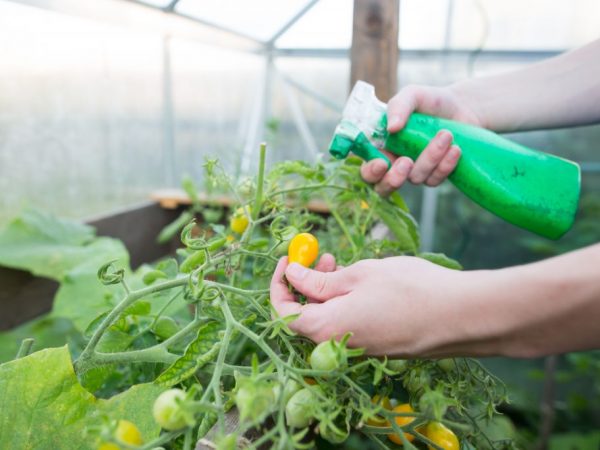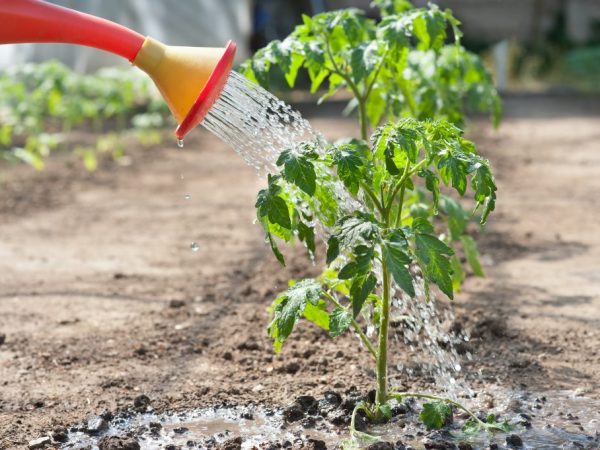Iodine as a groundbait for tomatoes
It is not only the well-known chemicals that help to increase the yield when growing vegetables in the garden in the open ground and in the greenhouse. Among the folk remedies there are many that can increase the home harvest, and one of them is iodine for tomatoes.

Iodine as a groundbait for tomatoes
The effect of iodine feeding
The lack of iodine for a tomato during the development of a vegetable crop adversely affects its future harvest. This is especially true in those regions where climatic conditions do not allow tomato seedlings to receive a lot of sunlight. Insufficient illumination in the greenhouse also has a detrimental effect on yield indicators. Iodine solutions can have a beneficial effect on plant growth, from the stage of tomato seedlings to the ripening of vegetables.
Fertilizing tomatoes with iodine and iodine solutions made on its basis leads to undoubted advantages:
- general improvement in the condition of tomato bushes,
- strengthening of stems and active growth of foliage in tomatoes,
- reducing the ripening period of tomatoes,
- an increase in vegetables in size.
In addition to these useful properties in the agricultural technology of growing vegetables in open ground and in a greenhouse, the use of spraying tomato bushes with iodine and solutions made on its basis protects against pathogenic microbes, fungal diseases and insect pests. It is advised to feed and fertilize the root part with iodine for treatment, reviews of gardeners who practice iodine for tomatoes in a greenhouse and in an open garden, already at the stage of growing tomato seedlings.
As tomato lovers note, many varieties, in the process of fertilizing with iodine and solutions made on its basis, accumulate with iodine in ripe tomatoes a large amount of vitamin C useful for us, simultaneously increasing the taste.
Terms for iodine dressings
As already noted, among experienced gardeners, feeding tomatoes with iodine and solutions prepared on its basis begins at the very beginning of growing tomato seedlings, which undoubtedly helps to grow and develop correctly in the future vegetable culture. When fertilizing tomato seedlings, the vegetable crop is gaining strength sufficient for a successful subsequent transplant in open ground conditions or in a closed greenhouse.
Iodine for tomatoes as fertilizer for seedlings and bushes can be used and watered several times in one season, as needed. The deadline for this is the end of summer. Iodine feeding for tomatoes ends by mid-August.
After the initial feeding of tomato seedlings, fertilization with iodine fertilization occurs a second time after two weeks from the moment the tomato seedlings are transplanted into open ground or a closed greenhouse. Re-feeding tomatoes with iodine is important for the formation of increased plant resistance to the environment, helping to take root after transplantation.
Top dressing recipe

When preparing the solution, observe the proportions
Fertilizing a tomato with iodine is used in the form of solutions prepared on its basis, based on water. Sometimes gardeners add additional components to such solutions. For the preparation of bait, ordinary iodine, sold in drugstore kiosks, is suitable.
In order to avoid burning tomato bushes with iodine, it is required to observe the proportions and norms specified in the instructions on how to water tomatoes with iodine.
The required standard and the required recipe for the preparation and use of iodine-based solutions depends on the purpose of the feeding:
- when fertilizing tomato seedlings with iodine, a water-based solution is prepared, from a proportion of 3 liters 1 pipette drop,
- when baiting only planted tomato bushes, 3 pipette drops of iodine are dissolved in a 10-liter bucket of water,
- for watering the root and foliar systems of tomato plants planted in open ground or in a greenhouse, about 4 - 5 pipette drops of iodine are required on a bucket of water,
- when feeding adult tomato bushes for whey, about 20 pipette drops of iodine will be needed per ten-liter bucket,
- when feeding at the stage of tomato ripening, a concentrated solution is made with ash infused in water for an hour in a ratio of 5 to 3, mixed with boric acid (10 g) and iodine (10 ml), a liter of such concentrate is diluted in a 10-liter bucket of water,
- in the fight against plant diseases, including late blight, you will need a liter of serum, a large spoonful of hydrogen peroxide, 40 drops of iodine and a ten-liter bucket of water.
Also, iodine bait against late blight can be mixed with potassium permanganate, but in the presence of late blight, they do not use green fertilizer for tomatoes.
The order of iodine bait
The effectiveness of processing by baiting or spraying tomato bushes with a prepared iodine solution is determined by each gardener independently, based on the size of the plot or greenhouse. The recommendations developed by experienced gardeners who practice fertilizing tomatoes with iodine when growing them will allow you to choose the most suitable option for how to water and fertilize the crop:
- at the stage of growing tomato seedlings, iodine bait will be enough, this is enough for the tomatoes to use iodine as a source of strength for the subsequent transplantation of a vegetable crop into open ground or into a closed greenhouse,
- after the transplant, the standard for watering tomato seedlings is at least a liter per 1 tomato bush,
- subsequent watering of tomato bushes that have taken root in the open ground and in the greenhouse requires at least 2 liters per 1 unit, such watering, in the same amount for both the open area and the greenhouse, one per week is enough,
- once - twice in one gardening season, adult tomato bushes with whey are fed, which improves the ripening of vegetables and destroys pests and pathogenic microbes, this is done by watering directly under the root or in the bed furrows.
Iodine groundbait for feeding tomatoes, provided in the fight against diseases of tomatoes, including against late blight, are intended for the spray treatment method. She can also not only spray, but also water the foliar and root systems of the bushes. Many people use the water-soluble pharmaceutical complex as a ready-made product. It is required to spray all the foliage, while it is worth sprinkling on both sides of the foliage. In some cases, gardeners prefer to replace whey with plain milk with a low fat content. To prepare a milk-based solution, you will need 250g, 1 liter of water and a few drops of iodine. Spraying is done at intervals of two weeks. Such folk remedies can be sprayed with tomatoes, cucumbers, zucchini and other vegetables and plants.
Some experienced gardeners resort to spraying with an iodine solution (3-4 pipette drops per 8 liters of water) of tomatoes and cucumbers even before the ovaries appear, hurrying to process the foliar part after the stage of growing seedlings, doing this procedure at two-week intervals.
A short excursion about what can be achieved when watering tomatoes with iodine, and instructions on how to do it correctly, why, how much and when to water, you can watch the numerous videos of experienced summer residents who will tell you about the intricacies of iodine bait.


